Corporate Accounting ACC202: Essay on Fair Value Accounting
VerifiedAdded on 2022/11/17
|9
|1799
|173
Essay
AI Summary
This essay delves into the importance of employing a suitable measurement approach for the development and presentation of financial information within corporate accounts, with a specific focus on fair value accounting. It examines the relevance of fair value accounting in the modern business environment, highlighting its applicability across various private and public sector organizations. The essay also evaluates the impact of fair value accounting on financial crises, such as the subprime mortgage crisis. Part B includes a case study comparing Wesfarmers and Woolworths, analyzing their application of fair value accounting for assets like accounts receivables, equity securities, and financial instruments, referencing their 2018 annual reports and the fair value hierarchy levels used. The essay references the works of Laux and Leuz (2009), Whittington (2008) and other academic sources.
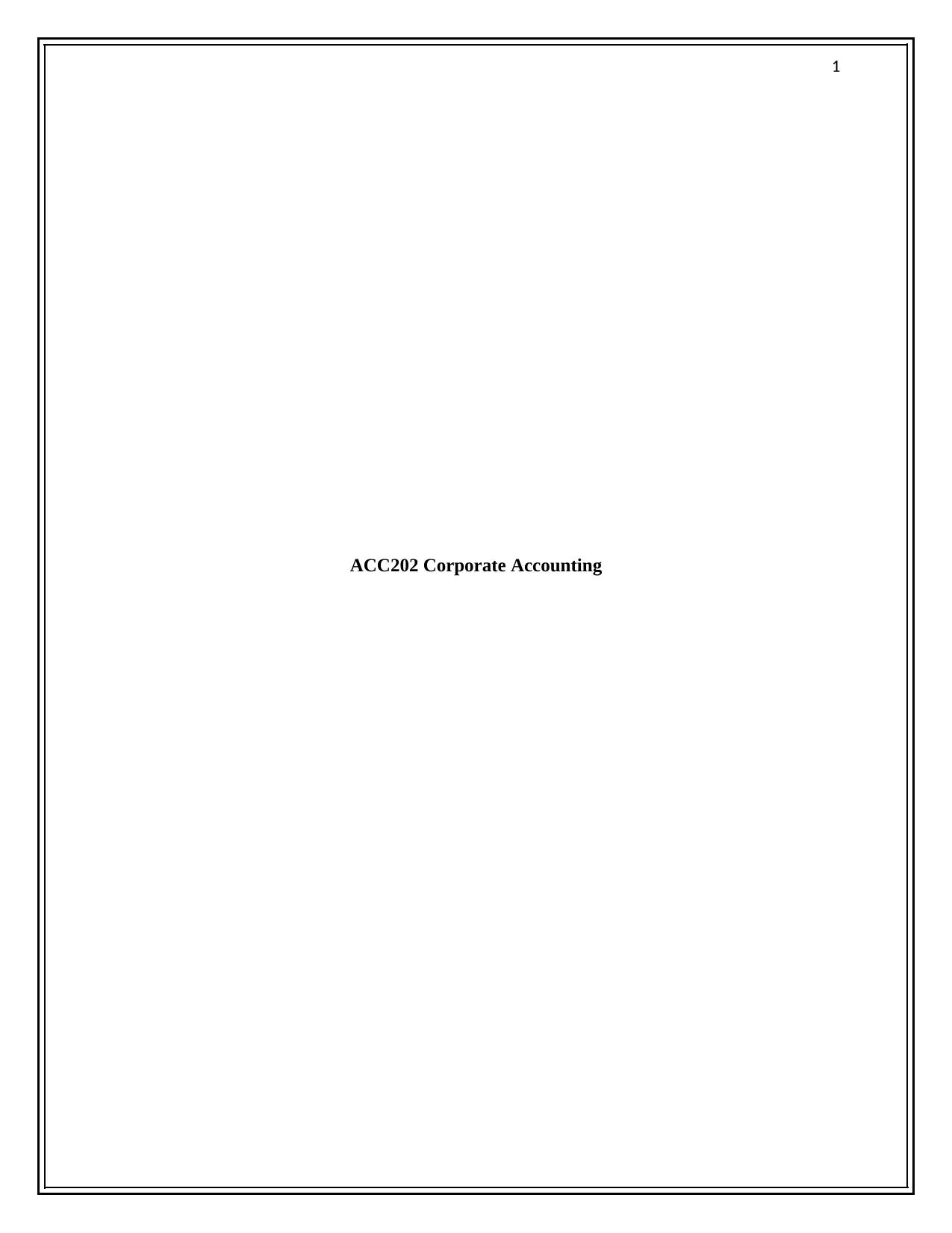
1
ACC202 Corporate Accounting
ACC202 Corporate Accounting
Paraphrase This Document
Need a fresh take? Get an instant paraphrase of this document with our AI Paraphraser
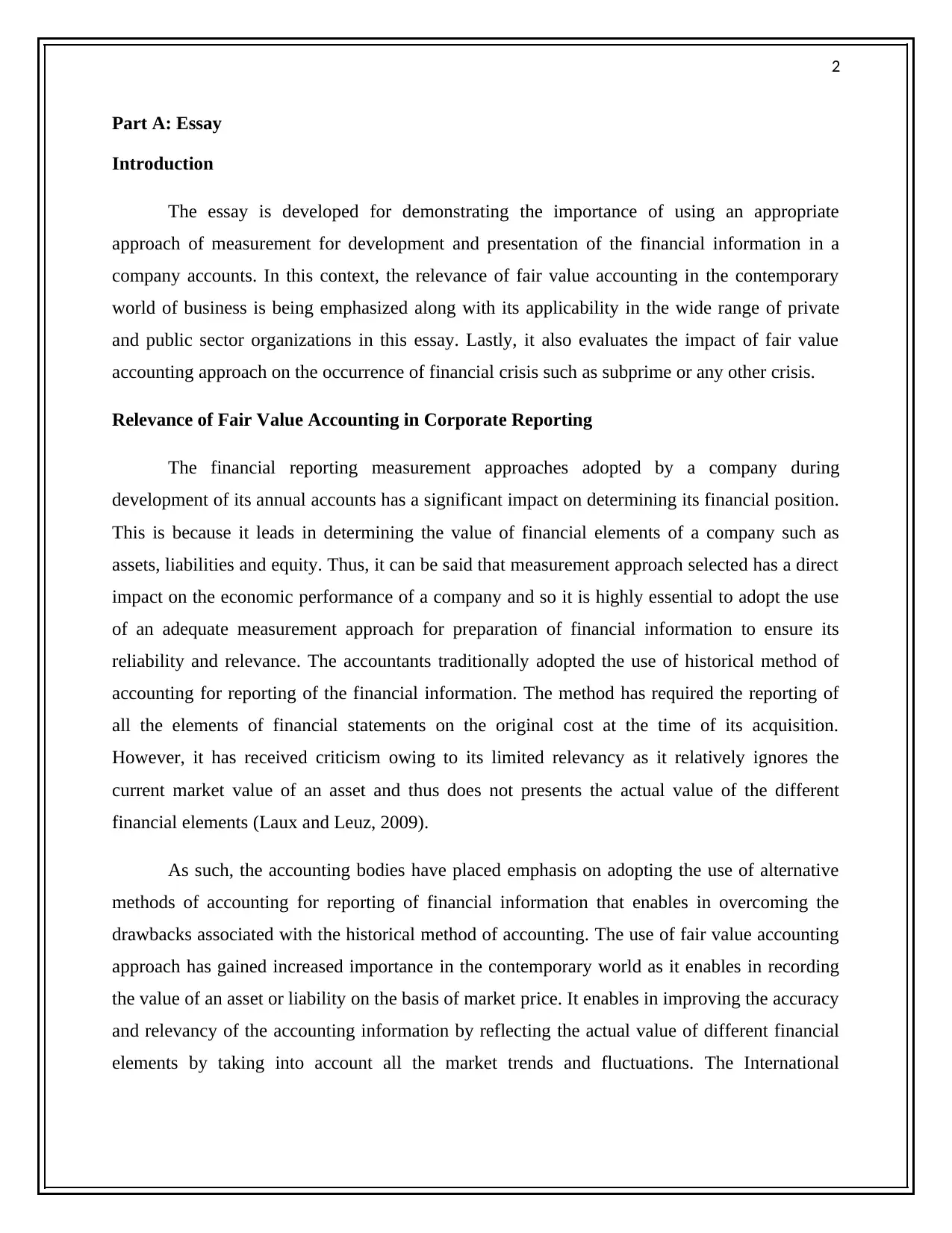
2
Part A: Essay
Introduction
The essay is developed for demonstrating the importance of using an appropriate
approach of measurement for development and presentation of the financial information in a
company accounts. In this context, the relevance of fair value accounting in the contemporary
world of business is being emphasized along with its applicability in the wide range of private
and public sector organizations in this essay. Lastly, it also evaluates the impact of fair value
accounting approach on the occurrence of financial crisis such as subprime or any other crisis.
Relevance of Fair Value Accounting in Corporate Reporting
The financial reporting measurement approaches adopted by a company during
development of its annual accounts has a significant impact on determining its financial position.
This is because it leads in determining the value of financial elements of a company such as
assets, liabilities and equity. Thus, it can be said that measurement approach selected has a direct
impact on the economic performance of a company and so it is highly essential to adopt the use
of an adequate measurement approach for preparation of financial information to ensure its
reliability and relevance. The accountants traditionally adopted the use of historical method of
accounting for reporting of the financial information. The method has required the reporting of
all the elements of financial statements on the original cost at the time of its acquisition.
However, it has received criticism owing to its limited relevancy as it relatively ignores the
current market value of an asset and thus does not presents the actual value of the different
financial elements (Laux and Leuz, 2009).
As such, the accounting bodies have placed emphasis on adopting the use of alternative
methods of accounting for reporting of financial information that enables in overcoming the
drawbacks associated with the historical method of accounting. The use of fair value accounting
approach has gained increased importance in the contemporary world as it enables in recording
the value of an asset or liability on the basis of market price. It enables in improving the accuracy
and relevancy of the accounting information by reflecting the actual value of different financial
elements by taking into account all the market trends and fluctuations. The International
Part A: Essay
Introduction
The essay is developed for demonstrating the importance of using an appropriate
approach of measurement for development and presentation of the financial information in a
company accounts. In this context, the relevance of fair value accounting in the contemporary
world of business is being emphasized along with its applicability in the wide range of private
and public sector organizations in this essay. Lastly, it also evaluates the impact of fair value
accounting approach on the occurrence of financial crisis such as subprime or any other crisis.
Relevance of Fair Value Accounting in Corporate Reporting
The financial reporting measurement approaches adopted by a company during
development of its annual accounts has a significant impact on determining its financial position.
This is because it leads in determining the value of financial elements of a company such as
assets, liabilities and equity. Thus, it can be said that measurement approach selected has a direct
impact on the economic performance of a company and so it is highly essential to adopt the use
of an adequate measurement approach for preparation of financial information to ensure its
reliability and relevance. The accountants traditionally adopted the use of historical method of
accounting for reporting of the financial information. The method has required the reporting of
all the elements of financial statements on the original cost at the time of its acquisition.
However, it has received criticism owing to its limited relevancy as it relatively ignores the
current market value of an asset and thus does not presents the actual value of the different
financial elements (Laux and Leuz, 2009).
As such, the accounting bodies have placed emphasis on adopting the use of alternative
methods of accounting for reporting of financial information that enables in overcoming the
drawbacks associated with the historical method of accounting. The use of fair value accounting
approach has gained increased importance in the contemporary world as it enables in recording
the value of an asset or liability on the basis of market price. It enables in improving the accuracy
and relevancy of the accounting information by reflecting the actual value of different financial
elements by taking into account all the market trends and fluctuations. The International
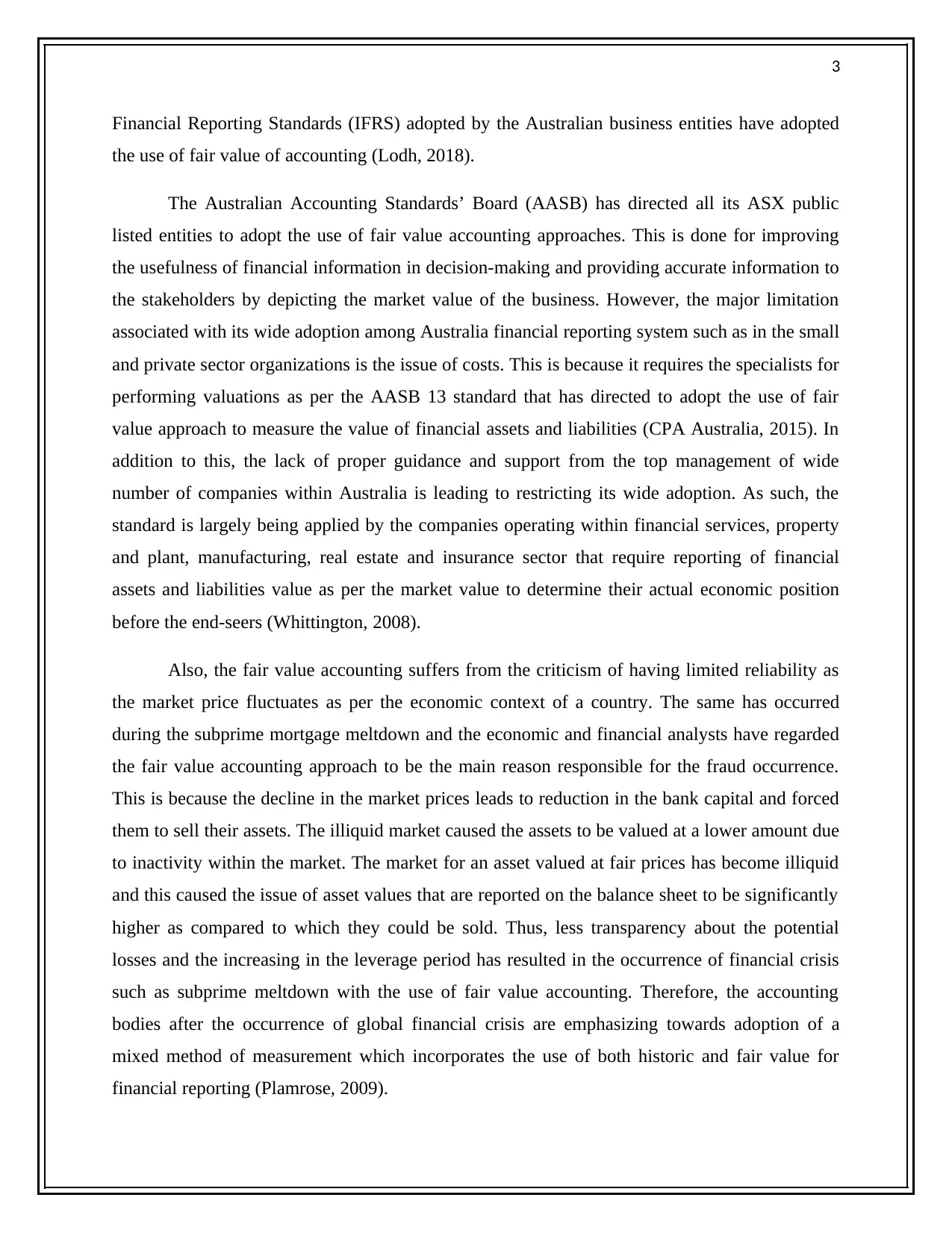
3
Financial Reporting Standards (IFRS) adopted by the Australian business entities have adopted
the use of fair value of accounting (Lodh, 2018).
The Australian Accounting Standards’ Board (AASB) has directed all its ASX public
listed entities to adopt the use of fair value accounting approaches. This is done for improving
the usefulness of financial information in decision-making and providing accurate information to
the stakeholders by depicting the market value of the business. However, the major limitation
associated with its wide adoption among Australia financial reporting system such as in the small
and private sector organizations is the issue of costs. This is because it requires the specialists for
performing valuations as per the AASB 13 standard that has directed to adopt the use of fair
value approach to measure the value of financial assets and liabilities (CPA Australia, 2015). In
addition to this, the lack of proper guidance and support from the top management of wide
number of companies within Australia is leading to restricting its wide adoption. As such, the
standard is largely being applied by the companies operating within financial services, property
and plant, manufacturing, real estate and insurance sector that require reporting of financial
assets and liabilities value as per the market value to determine their actual economic position
before the end-seers (Whittington, 2008).
Also, the fair value accounting suffers from the criticism of having limited reliability as
the market price fluctuates as per the economic context of a country. The same has occurred
during the subprime mortgage meltdown and the economic and financial analysts have regarded
the fair value accounting approach to be the main reason responsible for the fraud occurrence.
This is because the decline in the market prices leads to reduction in the bank capital and forced
them to sell their assets. The illiquid market caused the assets to be valued at a lower amount due
to inactivity within the market. The market for an asset valued at fair prices has become illiquid
and this caused the issue of asset values that are reported on the balance sheet to be significantly
higher as compared to which they could be sold. Thus, less transparency about the potential
losses and the increasing in the leverage period has resulted in the occurrence of financial crisis
such as subprime meltdown with the use of fair value accounting. Therefore, the accounting
bodies after the occurrence of global financial crisis are emphasizing towards adoption of a
mixed method of measurement which incorporates the use of both historic and fair value for
financial reporting (Plamrose, 2009).
Financial Reporting Standards (IFRS) adopted by the Australian business entities have adopted
the use of fair value of accounting (Lodh, 2018).
The Australian Accounting Standards’ Board (AASB) has directed all its ASX public
listed entities to adopt the use of fair value accounting approaches. This is done for improving
the usefulness of financial information in decision-making and providing accurate information to
the stakeholders by depicting the market value of the business. However, the major limitation
associated with its wide adoption among Australia financial reporting system such as in the small
and private sector organizations is the issue of costs. This is because it requires the specialists for
performing valuations as per the AASB 13 standard that has directed to adopt the use of fair
value approach to measure the value of financial assets and liabilities (CPA Australia, 2015). In
addition to this, the lack of proper guidance and support from the top management of wide
number of companies within Australia is leading to restricting its wide adoption. As such, the
standard is largely being applied by the companies operating within financial services, property
and plant, manufacturing, real estate and insurance sector that require reporting of financial
assets and liabilities value as per the market value to determine their actual economic position
before the end-seers (Whittington, 2008).
Also, the fair value accounting suffers from the criticism of having limited reliability as
the market price fluctuates as per the economic context of a country. The same has occurred
during the subprime mortgage meltdown and the economic and financial analysts have regarded
the fair value accounting approach to be the main reason responsible for the fraud occurrence.
This is because the decline in the market prices leads to reduction in the bank capital and forced
them to sell their assets. The illiquid market caused the assets to be valued at a lower amount due
to inactivity within the market. The market for an asset valued at fair prices has become illiquid
and this caused the issue of asset values that are reported on the balance sheet to be significantly
higher as compared to which they could be sold. Thus, less transparency about the potential
losses and the increasing in the leverage period has resulted in the occurrence of financial crisis
such as subprime meltdown with the use of fair value accounting. Therefore, the accounting
bodies after the occurrence of global financial crisis are emphasizing towards adoption of a
mixed method of measurement which incorporates the use of both historic and fair value for
financial reporting (Plamrose, 2009).
⊘ This is a preview!⊘
Do you want full access?
Subscribe today to unlock all pages.

Trusted by 1+ million students worldwide
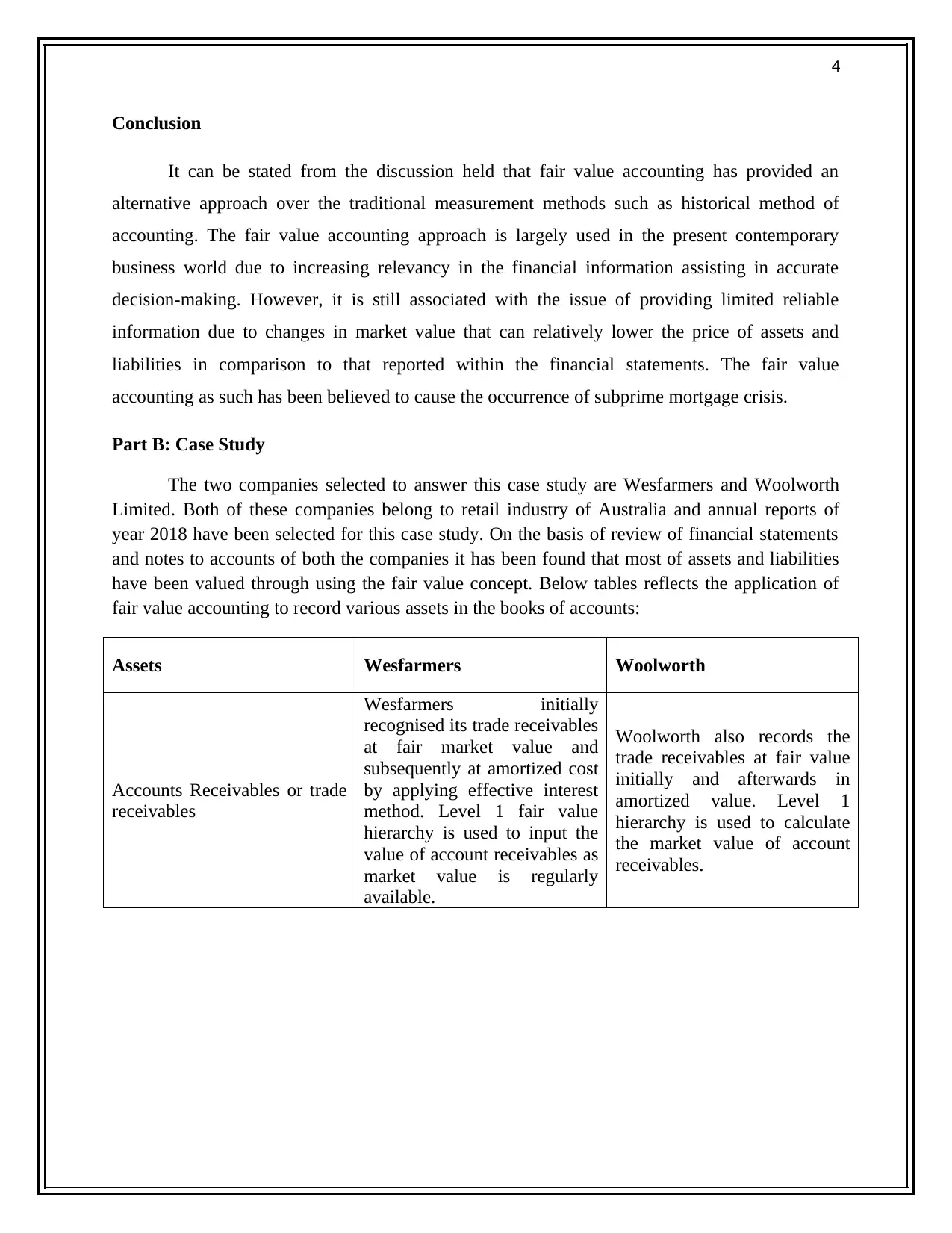
4
Conclusion
It can be stated from the discussion held that fair value accounting has provided an
alternative approach over the traditional measurement methods such as historical method of
accounting. The fair value accounting approach is largely used in the present contemporary
business world due to increasing relevancy in the financial information assisting in accurate
decision-making. However, it is still associated with the issue of providing limited reliable
information due to changes in market value that can relatively lower the price of assets and
liabilities in comparison to that reported within the financial statements. The fair value
accounting as such has been believed to cause the occurrence of subprime mortgage crisis.
Part B: Case Study
The two companies selected to answer this case study are Wesfarmers and Woolworth
Limited. Both of these companies belong to retail industry of Australia and annual reports of
year 2018 have been selected for this case study. On the basis of review of financial statements
and notes to accounts of both the companies it has been found that most of assets and liabilities
have been valued through using the fair value concept. Below tables reflects the application of
fair value accounting to record various assets in the books of accounts:
Assets Wesfarmers Woolworth
Accounts Receivables or trade
receivables
Wesfarmers initially
recognised its trade receivables
at fair market value and
subsequently at amortized cost
by applying effective interest
method. Level 1 fair value
hierarchy is used to input the
value of account receivables as
market value is regularly
available.
Woolworth also records the
trade receivables at fair value
initially and afterwards in
amortized value. Level 1
hierarchy is used to calculate
the market value of account
receivables.
Conclusion
It can be stated from the discussion held that fair value accounting has provided an
alternative approach over the traditional measurement methods such as historical method of
accounting. The fair value accounting approach is largely used in the present contemporary
business world due to increasing relevancy in the financial information assisting in accurate
decision-making. However, it is still associated with the issue of providing limited reliable
information due to changes in market value that can relatively lower the price of assets and
liabilities in comparison to that reported within the financial statements. The fair value
accounting as such has been believed to cause the occurrence of subprime mortgage crisis.
Part B: Case Study
The two companies selected to answer this case study are Wesfarmers and Woolworth
Limited. Both of these companies belong to retail industry of Australia and annual reports of
year 2018 have been selected for this case study. On the basis of review of financial statements
and notes to accounts of both the companies it has been found that most of assets and liabilities
have been valued through using the fair value concept. Below tables reflects the application of
fair value accounting to record various assets in the books of accounts:
Assets Wesfarmers Woolworth
Accounts Receivables or trade
receivables
Wesfarmers initially
recognised its trade receivables
at fair market value and
subsequently at amortized cost
by applying effective interest
method. Level 1 fair value
hierarchy is used to input the
value of account receivables as
market value is regularly
available.
Woolworth also records the
trade receivables at fair value
initially and afterwards in
amortized value. Level 1
hierarchy is used to calculate
the market value of account
receivables.
Paraphrase This Document
Need a fresh take? Get an instant paraphrase of this document with our AI Paraphraser
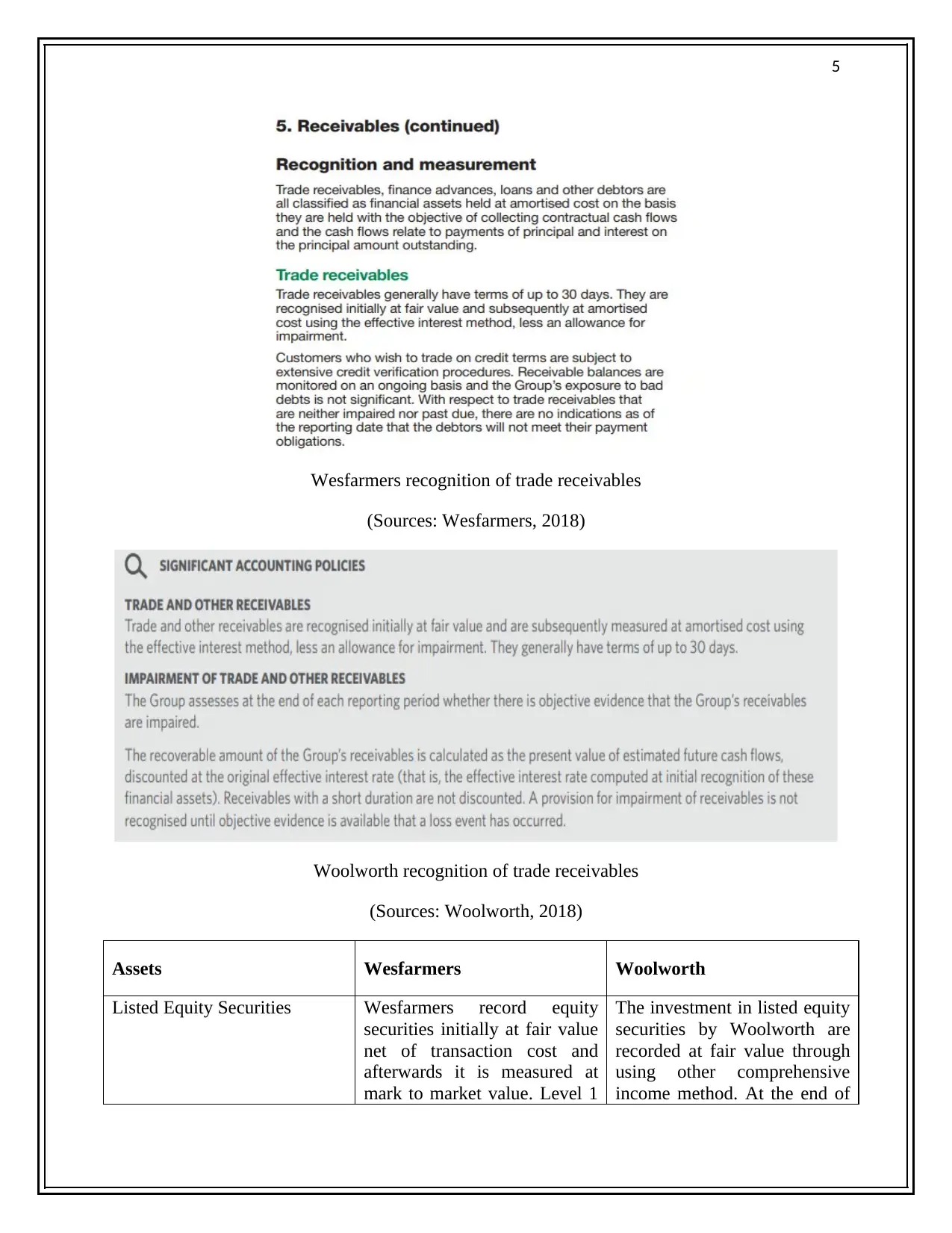
5
Wesfarmers recognition of trade receivables
(Sources: Wesfarmers, 2018)
Woolworth recognition of trade receivables
(Sources: Woolworth, 2018)
Assets Wesfarmers Woolworth
Listed Equity Securities Wesfarmers record equity
securities initially at fair value
net of transaction cost and
afterwards it is measured at
mark to market value. Level 1
The investment in listed equity
securities by Woolworth are
recorded at fair value through
using other comprehensive
income method. At the end of
Wesfarmers recognition of trade receivables
(Sources: Wesfarmers, 2018)
Woolworth recognition of trade receivables
(Sources: Woolworth, 2018)
Assets Wesfarmers Woolworth
Listed Equity Securities Wesfarmers record equity
securities initially at fair value
net of transaction cost and
afterwards it is measured at
mark to market value. Level 1
The investment in listed equity
securities by Woolworth are
recorded at fair value through
using other comprehensive
income method. At the end of
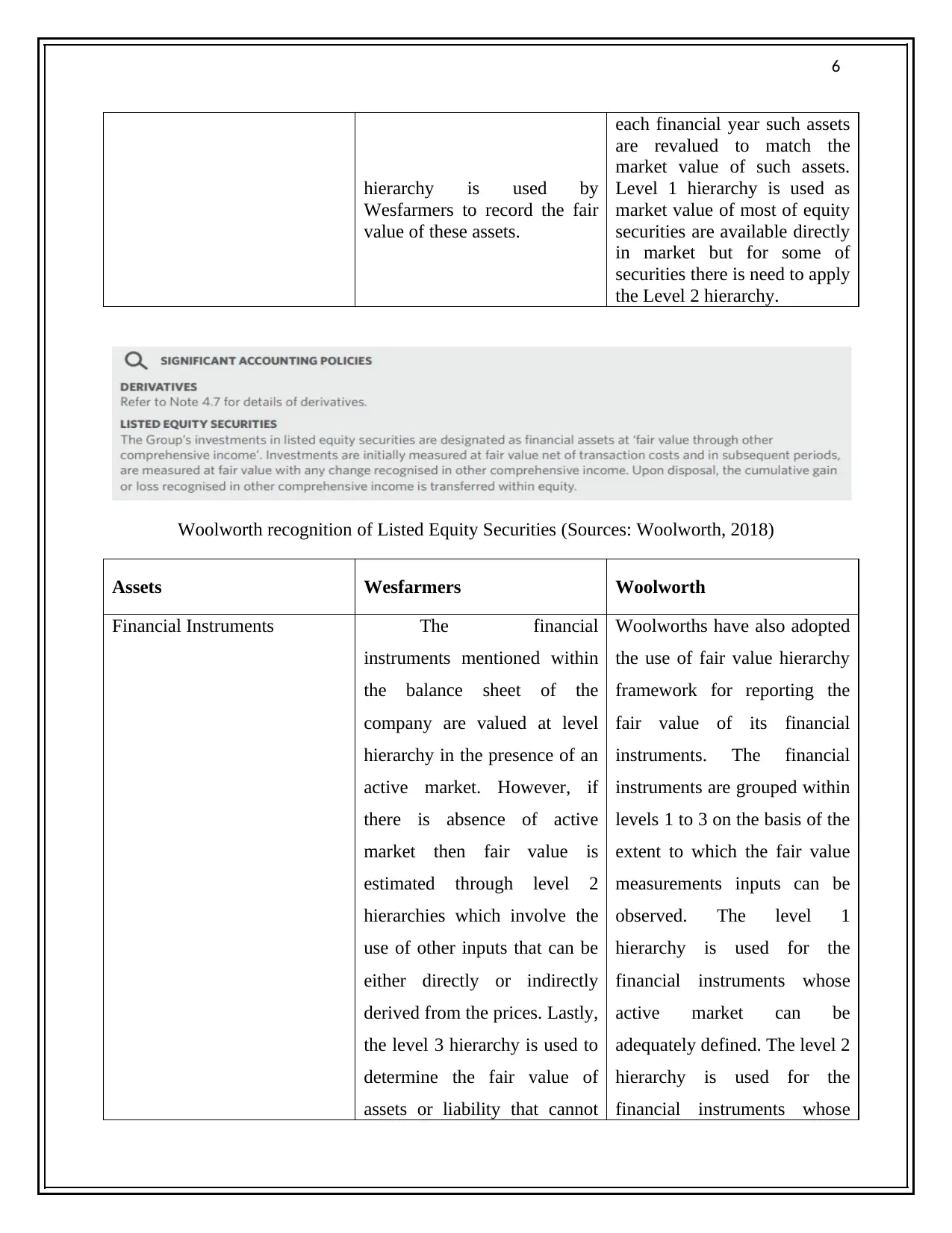
6
hierarchy is used by
Wesfarmers to record the fair
value of these assets.
each financial year such assets
are revalued to match the
market value of such assets.
Level 1 hierarchy is used as
market value of most of equity
securities are available directly
in market but for some of
securities there is need to apply
the Level 2 hierarchy.
Woolworth recognition of Listed Equity Securities (Sources: Woolworth, 2018)
Assets Wesfarmers Woolworth
Financial Instruments The financial
instruments mentioned within
the balance sheet of the
company are valued at level
hierarchy in the presence of an
active market. However, if
there is absence of active
market then fair value is
estimated through level 2
hierarchies which involve the
use of other inputs that can be
either directly or indirectly
derived from the prices. Lastly,
the level 3 hierarchy is used to
determine the fair value of
assets or liability that cannot
Woolworths have also adopted
the use of fair value hierarchy
framework for reporting the
fair value of its financial
instruments. The financial
instruments are grouped within
levels 1 to 3 on the basis of the
extent to which the fair value
measurements inputs can be
observed. The level 1
hierarchy is used for the
financial instruments whose
active market can be
adequately defined. The level 2
hierarchy is used for the
financial instruments whose
hierarchy is used by
Wesfarmers to record the fair
value of these assets.
each financial year such assets
are revalued to match the
market value of such assets.
Level 1 hierarchy is used as
market value of most of equity
securities are available directly
in market but for some of
securities there is need to apply
the Level 2 hierarchy.
Woolworth recognition of Listed Equity Securities (Sources: Woolworth, 2018)
Assets Wesfarmers Woolworth
Financial Instruments The financial
instruments mentioned within
the balance sheet of the
company are valued at level
hierarchy in the presence of an
active market. However, if
there is absence of active
market then fair value is
estimated through level 2
hierarchies which involve the
use of other inputs that can be
either directly or indirectly
derived from the prices. Lastly,
the level 3 hierarchy is used to
determine the fair value of
assets or liability that cannot
Woolworths have also adopted
the use of fair value hierarchy
framework for reporting the
fair value of its financial
instruments. The financial
instruments are grouped within
levels 1 to 3 on the basis of the
extent to which the fair value
measurements inputs can be
observed. The level 1
hierarchy is used for the
financial instruments whose
active market can be
adequately defined. The level 2
hierarchy is used for the
financial instruments whose
⊘ This is a preview!⊘
Do you want full access?
Subscribe today to unlock all pages.

Trusted by 1+ million students worldwide
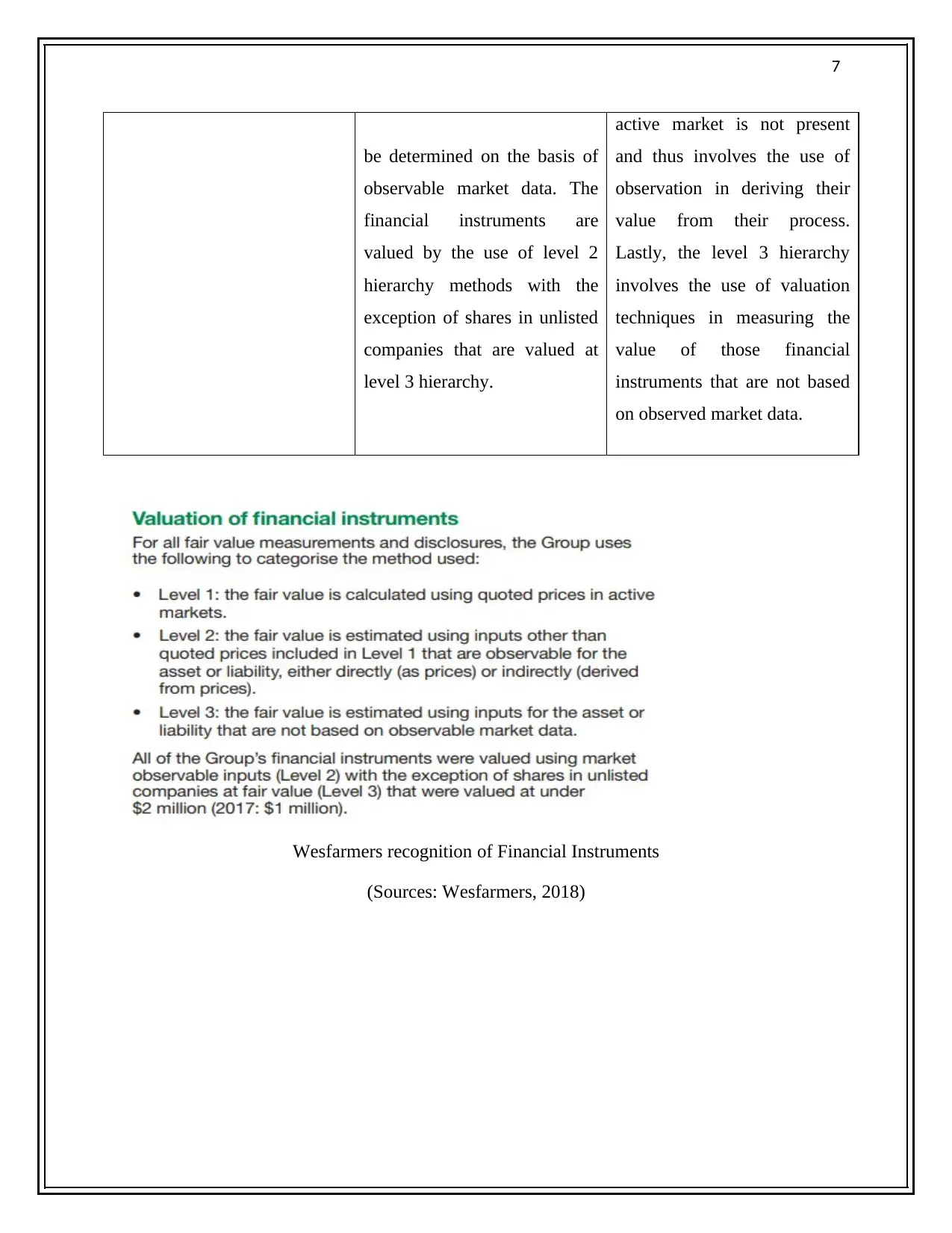
7
be determined on the basis of
observable market data. The
financial instruments are
valued by the use of level 2
hierarchy methods with the
exception of shares in unlisted
companies that are valued at
level 3 hierarchy.
active market is not present
and thus involves the use of
observation in deriving their
value from their process.
Lastly, the level 3 hierarchy
involves the use of valuation
techniques in measuring the
value of those financial
instruments that are not based
on observed market data.
Wesfarmers recognition of Financial Instruments
(Sources: Wesfarmers, 2018)
be determined on the basis of
observable market data. The
financial instruments are
valued by the use of level 2
hierarchy methods with the
exception of shares in unlisted
companies that are valued at
level 3 hierarchy.
active market is not present
and thus involves the use of
observation in deriving their
value from their process.
Lastly, the level 3 hierarchy
involves the use of valuation
techniques in measuring the
value of those financial
instruments that are not based
on observed market data.
Wesfarmers recognition of Financial Instruments
(Sources: Wesfarmers, 2018)
Paraphrase This Document
Need a fresh take? Get an instant paraphrase of this document with our AI Paraphraser
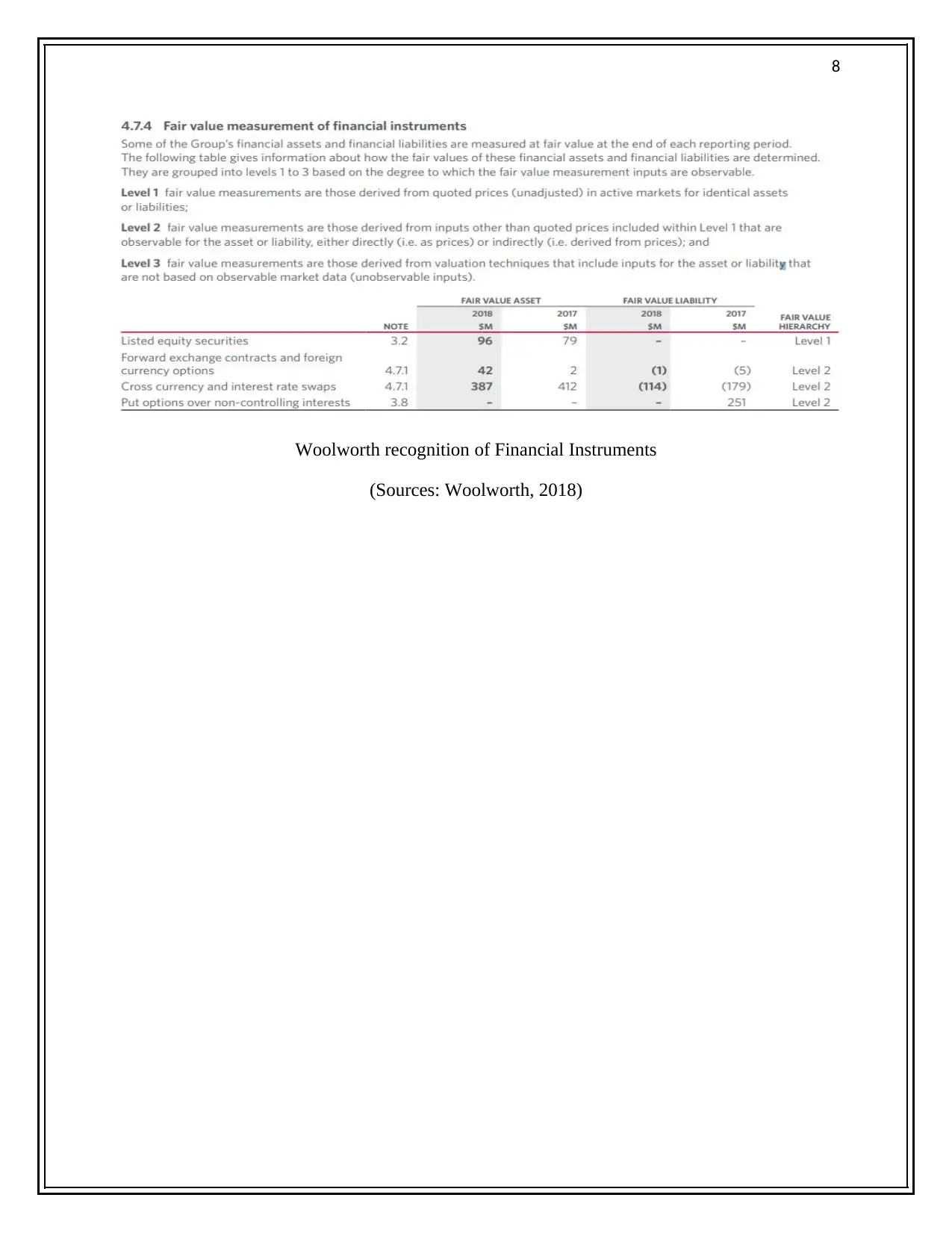
8
Woolworth recognition of Financial Instruments
(Sources: Woolworth, 2018)
Woolworth recognition of Financial Instruments
(Sources: Woolworth, 2018)
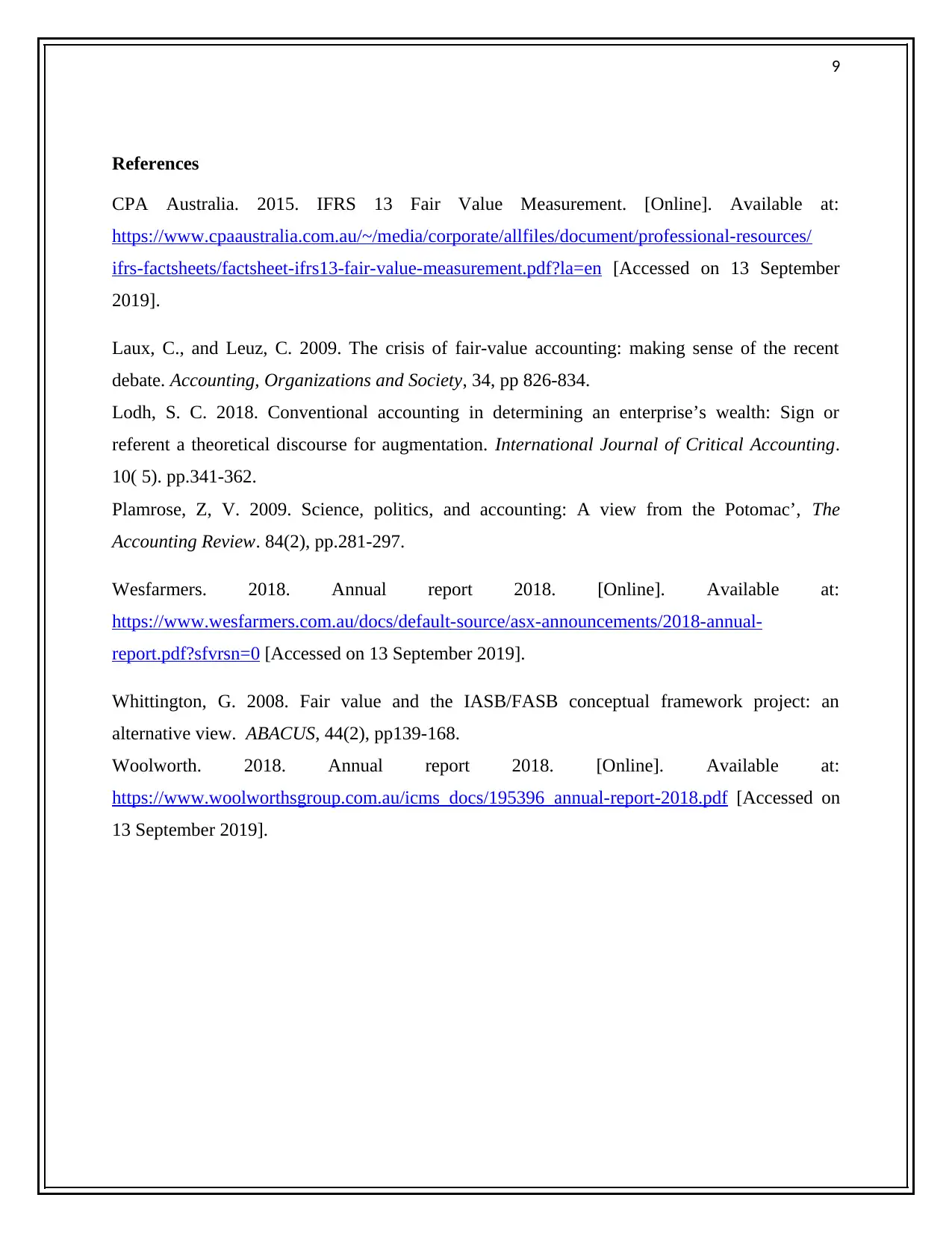
9
References
CPA Australia. 2015. IFRS 13 Fair Value Measurement. [Online]. Available at:
https://www.cpaaustralia.com.au/~/media/corporate/allfiles/document/professional-resources/
ifrs-factsheets/factsheet-ifrs13-fair-value-measurement.pdf?la=en [Accessed on 13 September
2019].
Laux, C., and Leuz, C. 2009. The crisis of fair-value accounting: making sense of the recent
debate. Accounting, Organizations and Society, 34, pp 826-834.
Lodh, S. C. 2018. Conventional accounting in determining an enterprise’s wealth: Sign or
referent a theoretical discourse for augmentation. International Journal of Critical Accounting.
10( 5). pp.341-362.
Plamrose, Z, V. 2009. Science, politics, and accounting: A view from the Potomac’, The
Accounting Review. 84(2), pp.281-297.
Wesfarmers. 2018. Annual report 2018. [Online]. Available at:
https://www.wesfarmers.com.au/docs/default-source/asx-announcements/2018-annual-
report.pdf?sfvrsn=0 [Accessed on 13 September 2019].
Whittington, G. 2008. Fair value and the IASB/FASB conceptual framework project: an
alternative view. ABACUS, 44(2), pp139-168.
Woolworth. 2018. Annual report 2018. [Online]. Available at:
https://www.woolworthsgroup.com.au/icms_docs/195396_annual-report-2018.pdf [Accessed on
13 September 2019].
References
CPA Australia. 2015. IFRS 13 Fair Value Measurement. [Online]. Available at:
https://www.cpaaustralia.com.au/~/media/corporate/allfiles/document/professional-resources/
ifrs-factsheets/factsheet-ifrs13-fair-value-measurement.pdf?la=en [Accessed on 13 September
2019].
Laux, C., and Leuz, C. 2009. The crisis of fair-value accounting: making sense of the recent
debate. Accounting, Organizations and Society, 34, pp 826-834.
Lodh, S. C. 2018. Conventional accounting in determining an enterprise’s wealth: Sign or
referent a theoretical discourse for augmentation. International Journal of Critical Accounting.
10( 5). pp.341-362.
Plamrose, Z, V. 2009. Science, politics, and accounting: A view from the Potomac’, The
Accounting Review. 84(2), pp.281-297.
Wesfarmers. 2018. Annual report 2018. [Online]. Available at:
https://www.wesfarmers.com.au/docs/default-source/asx-announcements/2018-annual-
report.pdf?sfvrsn=0 [Accessed on 13 September 2019].
Whittington, G. 2008. Fair value and the IASB/FASB conceptual framework project: an
alternative view. ABACUS, 44(2), pp139-168.
Woolworth. 2018. Annual report 2018. [Online]. Available at:
https://www.woolworthsgroup.com.au/icms_docs/195396_annual-report-2018.pdf [Accessed on
13 September 2019].
⊘ This is a preview!⊘
Do you want full access?
Subscribe today to unlock all pages.

Trusted by 1+ million students worldwide
1 out of 9
Related Documents
Your All-in-One AI-Powered Toolkit for Academic Success.
+13062052269
info@desklib.com
Available 24*7 on WhatsApp / Email
![[object Object]](/_next/static/media/star-bottom.7253800d.svg)
Unlock your academic potential
Copyright © 2020–2025 A2Z Services. All Rights Reserved. Developed and managed by ZUCOL.





